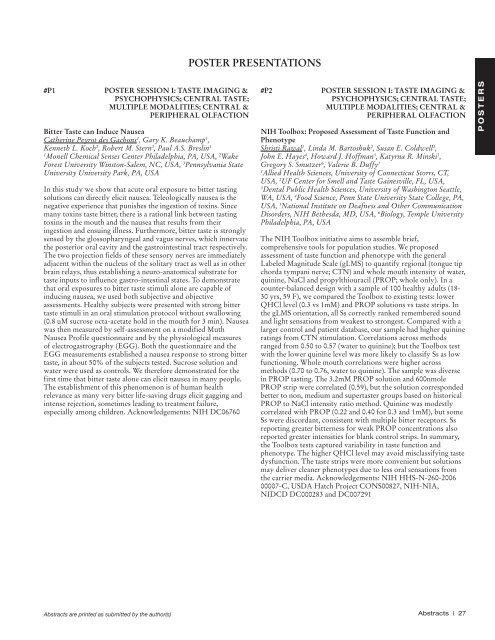Abstracts - Association for Chemoreception Sciences
Abstracts - Association for Chemoreception Sciences
Abstracts - Association for Chemoreception Sciences
Create successful ePaper yourself
Turn your PDF publications into a flip-book with our unique Google optimized e-Paper software.
POSTER PRESENTATIONS<br />
#P1 POSTER SESSION I: TASTE IMAGING &<br />
PSYCHOPHYSICS; CENTRAL TASTE;<br />
MULTIPLE MODALITIES; CENTRAL &<br />
PERIPHERAL OLFACTION<br />
Bitter Taste can Induce Nausea<br />
Catherine Peyrot des Gachons 1 , Gary K. Beauchamp 1 ,<br />
Kenneth L. Koch 2 , Robert M. Stern 3 , Paul A.S. Breslin 1<br />
1<br />
Monell Chemical Senses Center Philadelphia, PA, USA, 2 Wake<br />
Forest University Winston-Salem, NC, USA, 3 Pennsylvania State<br />
University University Park, PA, USA<br />
In this study we show that acute oral exposure to bitter tasting<br />
solutions can directly elicit nausea. Teleologically nausea is the<br />
negative experience that punishes the ingestion of toxins. Since<br />
many toxins taste bitter, there is a rational link between tasting<br />
toxins in the mouth and the nausea that results from their<br />
ingestion and ensuing illness. Furthermore, bitter taste is strongly<br />
sensed by the glossopharyngeal and vagus nerves, which innervate<br />
the posterior oral cavity and the gastrointestinal tract respectively.<br />
The two projection fields of these sensory nerves are immediately<br />
adjacent within the nucleus of the solitary tract as well as in other<br />
brain relays, thus establishing a neuro-anatomical substrate <strong>for</strong><br />
taste inputs to influence gastro-intestinal states. To demonstrate<br />
that oral exposures to bitter taste stimuli alone are capable of<br />
inducing nausea, we used both subjective and objective<br />
assessments. Healthy subjects were presented with strong bitter<br />
taste stimuli in an oral stimulation protocol without swallowing<br />
(0.8 uM sucrose octa-acetate hold in the mouth <strong>for</strong> 3 min). Nausea<br />
was then measured by self-assessment on a modified Muth<br />
Nausea Profile questionnaire and by the physiological measures<br />
of electrogastrography (EGG). Both the questionnaire and the<br />
EGG measurements established a nausea response to strong bitter<br />
taste, in about 50% of the subjects tested. Sucrose solution and<br />
water were used as controls. We there<strong>for</strong>e demonstrated <strong>for</strong> the<br />
first time that bitter taste alone can elicit nausea in many people.<br />
The establishment of this phenomenon is of human health<br />
relevance as many very bitter life-saving drugs elicit gagging and<br />
intense rejection, sometimes leading to treatment failure,<br />
especially among children. Acknowledgements: NIH DC06760<br />
#P2 POSTER SESSION I: TASTE IMAGING &<br />
PSYCHOPHYSICS; CENTRAL TASTE;<br />
MULTIPLE MODALITIES; CENTRAL &<br />
PERIPHERAL OLFACTION<br />
NIH Toolbox: Proposed Assessment of Taste Function and<br />
Phenotype<br />
Shristi Rawal 1 , Linda M. Bartoshuk 2 , Susan E. Coldwell 3 ,<br />
John E. Hayes 4 , Howard J. Hoffman 5 , Katyrna R. Minski 1 ,<br />
Gregory S. Smutzer 6 , Valerie B. Duffy 1<br />
1<br />
Allied Health <strong>Sciences</strong>, University of Connecticut Storrs, CT,<br />
USA, 2 UF Center <strong>for</strong> Smell and Taste Gainesville, FL, USA,<br />
3<br />
Dental Public Health <strong>Sciences</strong>, University of Washington Seattle,<br />
WA, USA, 4 Food Science, Penn State University State College, PA,<br />
USA, 5 National Institute on Deafness and Other Communication<br />
Disorders, NIH Bethesda, MD, USA, 6 Biology, Temple University<br />
Philadelphia, PA, USA<br />
The NIH Toolbox initiative aims to assemble brief,<br />
comprehensive tools <strong>for</strong> population studies. We proposed<br />
assessment of taste function and phenotype with the general<br />
Labeled Magnitude Scale (gLMS) to quantify regional (tongue tip<br />
chorda tympani nerve; CTN) and whole mouth intensity of water,<br />
quinine, NaCl and propylthiouracil (PROP; whole only). In a<br />
counter-balanced design with a sample of 100 healthy adults (18-<br />
30 yrs, 59 F), we compared the Toolbox to existing tests: lower<br />
QHCl level (0.3 vs 1mM) and PROP solutions vs taste strips. In<br />
the gLMS orientation, all Ss correctly ranked remembered sound<br />
and light sensations from weakest to strongest. Compared with a<br />
larger control and patient database, our sample had higher quinine<br />
ratings from CTN stimulation. Correlations across methods<br />
ranged from 0.50 to 0.57 (water to quinine); but the Toolbox test<br />
with the lower quinine level was more likely to classify Ss as low<br />
functioning. Whole mouth correlations were higher across<br />
methods (0.70 to 0.76, water to quinine). The sample was diverse<br />
in PROP tasting. The 3.2mM PROP solution and 600nmole<br />
PROP strip were correlated (0.59), but the solution corresponded<br />
better to non, medium and supertaster groups based on historical<br />
PROP to NaCl intensity ratio method. Quinine was modestly<br />
correlated with PROP (0.22 and 0.40 <strong>for</strong> 0.3 and 1mM), but some<br />
Ss were discordant, consistent with multiple bitter receptors. Ss<br />
reporting greater bitterness <strong>for</strong> weak PROP concentrations also<br />
reported greater intensities <strong>for</strong> blank control strips. In summary,<br />
the Toolbox tests captured variability in taste function and<br />
phenotype. The higher QHCl level may avoid misclassifying taste<br />
dysfunction. The taste strips were more convenient but solutions<br />
may deliver cleaner phenotypes due to less oral sensations from<br />
the carrier media. Acknowledgements: NIH HHS-N-260-2006<br />
00007-C, USDA Hatch Project CONS00827, NIH-NIA,<br />
NIDCD DC000283 and DC007291<br />
P O S T E R S<br />
<strong>Abstracts</strong> are printed as submitted by the author(s)<br />
<strong>Abstracts</strong> | 27
















